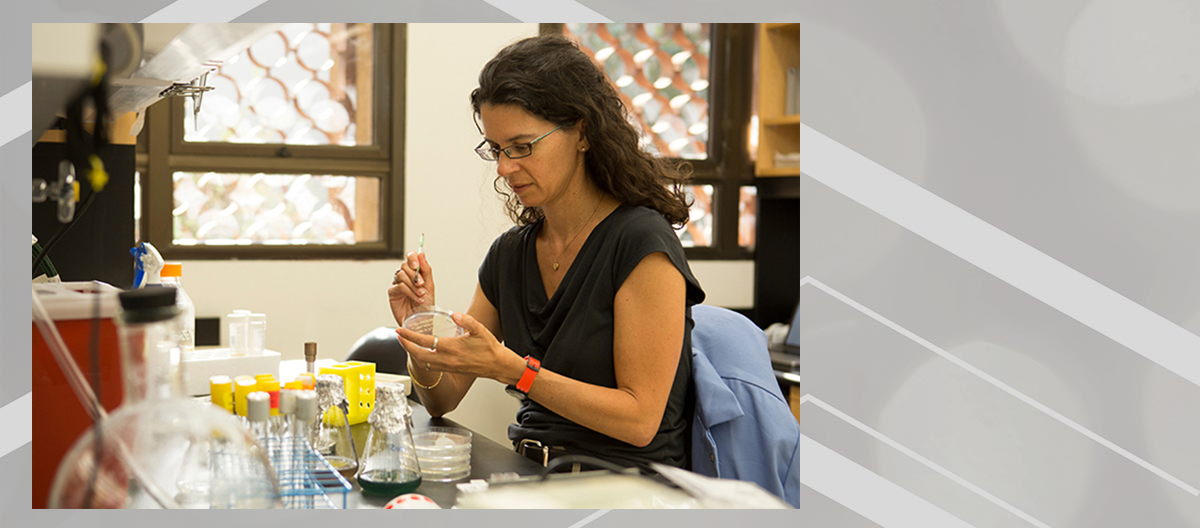How ancient microbes ‘invented’ metabolism

Microbial biochemistry holds the key to some of the most pressing problems facing society today. They can help explore how to generate renewable energy, feed the planet by sustainably providing fixed nitrogen to plants, fight bacterial infections, clean up oil spills, and so much more.
Studying ancient microbes gives scientists like Dianne Newman — who was recently named a 2016 MacArthur Fellow for her research on the role bacteria played in shaping the Earth — insights into how modern bacteria may survive in surprising places.
It’s important to understand how bacteria thrive — or don’t thrive — to keep dangerous bacteria out of hospitals and other places.
By being better informed about the chemistry of niches that support microbial survival within chronic infections, Dianne said she can design experiments in the laboratory to better mimic these environments and gain insight into relevant survival mechanisms. This has the potential to help us understand how infection can spread in emergency rooms or during medical procedures.
Humans wouldn’t be able to respire without microbes.
Microbes, as small as they are, played a large role in shaping the Earth’s geosphere, from ore-deposits to the composition of the atmosphere. Not to mention, they also “invented” the cellular process humans use to gain energy by breathing oxygen.
Scientists study microbial diversity to find out many things from ancient and present-day microbes. They can inform how current microbes thrive, how humans formed our respiration process, and more.
Bacteria thrived during a time when there was limited or no oxygen. And some of those techniques ancient bacteria used back then are still being used today.
By appreciating the metabolic diversity of microorganisms, we can begin to understand how bacteria thrive in habitats both on and within our bodies or in places that are devoid of oxygen.
“When we recognize that microbes had at least 1 billion years of history where they were making energy in the absence of oxygen, it reminds us that there are many environments on Earth today that are also anoxic [a place depleted of dissolved oxygen],” said Dianne.
To understand the history of life on Earth, consider the roles microbes played in shaping the geosphere.
Even places like the plaque on the surface of your teeth turn out to be anoxic. And microbes thrive there and other places without oxygen, just like they did in early Earth. Ancient microbes figured out how to cope and those same strategies are still relevant today.
Microbes have been critical catalysts in shaping the life we see on Earth today, according to Dianne.
“The oxygen in the air we breathe today is due to an ancient microorganism figuring out how to use water as a substrate for oxygenic photosynthesis,” she said. “That transformed the history of the planet and the history of life in profound ways.”
One of these ways is how humans are able to breathe and produce energy. Humans wouldn’t be able to respire without microbes, Dianne explained. Their ancient processes help us create energy.
“Inside each of our cells are organelles called mitochondria — the remnants of an ancient endosymbiotic event where a bacterium formed a partnership with some other type of microbe and became the energy powerhouse for the new merged cell-type,” Dianne said.
When humans breathe oxygen, that oxygen travels to the mitochondrion, where it serves as the landing pad for electrons that are generated by our metabolism of the food we eat.
“The ability to move those electrons through proteins within the mitochondrial membrane to ultimately land on oxygen is what aerobic respiration is all about,” she said. “This is how we generate energy.”
Microbial diversity represents the greatest diversity in the biological world.
Essentially, all metabolism on Earth was “invented” by microorganisms. This is just one reason why people should care about this research.
Dianne researches microorganisms by isolating bacteria from the environment or requesting previously-isolated strains from colleagues. She cultivates them in the laboratory under various conditions. She and other colleagues use genetic approaches to determine how bacteria catalyze reactions of interest, such as which genes control certain processes.
Microbes are also metabolically more sophisticated than humans are. They can “eat” and “breathe” a larger range of substrates.
Some microbes use oil as fuel, like cars. They have been known to actually chew hydrocarbons from oil spills. Sometimes to help in a spill cleanup, chemical dispersants are used to break oil down into smaller particles that microbes can then eat.
Microbes helped clean the Deepwater Horizon oil spill. They came to the rescue.
After the Deepwater Horizon spill, “populations of oil-degrading microbes boomed in some of Louisiana’s most heavily oiled marsh soils,” according to a 2015 Science News article on oil-munching microbes cleaning up the spill.
Microbes’ “ability to eat constituents of oil is why the Deepwater Horizon oil spill was cleaned up so quickly,” Dianne said. “The microbes came to the rescue.”
Oil-muncher microbes survived and pushed out other microbes in the area. And as oil levels have decreased over the years, the native microbial communities recovered.
Microbes are metabolically far more sophisticated than we are.
Microbial diversity represents the greatest diversity in the biological world. “It trumps insect diversity, or any other macroscopic life-form, for that matter,” Dianne said. This was demonstrated by pioneering evolutionary biologist Carl Woese decades ago. To understand the history of life on this planet, and how Earth evolved with respect to its chemical and physical properties, we have to consider the roles microbes played in shaping the geosphere, she explained.
Microbes have so much to teach us. The work of scientists like Dianne is critical to helping us find and apply new tools to solve our most pressing problems.


